Live on the homepage now!
Reader Supported News
Trump might clear the bar for incitement on January 6, and that’s far from his only legal risk.
Double Trouble
There is a reason I’ve written a number of articles and newsletters about Donald Trump’s potential criminal responsibility for his effort to overturn the 2020 presidential election. Investigations evolve. New evidence emerges. And the emerging evidence is increasing Trump’s legal risk on two key fronts. First, did he incite the attack on the Capitol on January 6? Second, did he engage in a criminal scheme under Georgia state law to reverse the results of the presidential election there?
To understand the incitement argument, we have to begin with the law. Federal law imposes criminal penalties on any person who “incites, sets on foot, assists, or engages in any rebellion or insurrection against the authority of the United States or the laws thereof, or gives aid or comfort thereto.”
Yet this provision has to be read in light of the very strong First Amendment interests at play. Americans have a right to call for even violent civil unrest, unless “such advocacy is directed to inciting or producing imminent lawless action and is likely to incite or produce such action.” This is a very high bar to clear, but Donald Trump’s conduct just might clear it.
Since the mob actually launched its violent assault during and immediately after Trump’s speech urging them to march to the Capitol, the “imminence” test is plainly met. Thus, the key question is whether Trump actually intended the violent result. If you think the answer is obvious (after all, he whipped the crowd into a frenzy and sent them straight to Congress), then think again. The case is closer than you might think.
Trump’s legal defense primarily depends on statements and tweets that urged the crowd to march “peacefully and patriotically” and then later to “remain peaceful” and “stay peaceful.” Ordinarily such calls for calm would end the criminal inquiry. How can you prosecute a man for incitement when he calls for peace?
But that’s not all he said, and that’s not all he did. As I explained at length in a previous story in The Atlantic, the totality of the circumstances changes the equation. He summoned the mob (promising the protest would be “wild”), there’s evidence he knew the crowd was armed, and he told that same crowd to “fight like hell.” Other speakers urged “trial by combat” and asked the crowd to sacrifice “their blood, their sweat, their tears” and even perhaps their very lives.
Then, when the attack was under way, he inflamed the crowd by tweeting that “Mike Pence didn’t have the courage to do what was necessary.” Did yesterday’s hearing add anything to this narrative? Yes, modestly. Here’s a summary of the key evidence, from The New York Times:
As a mob of his supporters assaulted the Capitol, former President Donald J. Trump sat in his dining room off the Oval Office, watching the violence on television and choosing to do nothing for hours to stop it, an array of former administration officials testified to the House committee investigating the Jan. 6 attack in accounts laid out on Thursday.
In a final public hearing of the summer and one of the most dramatic of the inquiry, the panel provided a panoramic account of how, even as the lives of law enforcement officers, members of Congress and his own vice president were under threat, Mr. Trump could not be moved to act until after it was clear that the riot had failed to disrupt Congress’s session to confirm his election defeat.
If I was standing in front of a jury, I’d ask them to ponder a question—if Trump truly wanted only a “peaceful” protest, why did he passively allow the horrific violence to unfold? Why was it ultimately up to Mike Pence to skip the chain of command and call out the National Guard?
The answer, I’d argue, was that everything was happening precisely as Trump had intended. The mob was supposed to march to the Capitol. It was supposed to stop the certification. Why would Trump call it off when it was doing exactly what he wanted it to do?
Again, there are strong defenses to any prosecution for incitement. Trump’s calls for peace may convince the Department of Justice that an incitement prosecution is simply too tough to mount, in spite of all the additional evidence outlined above. Or Trump’s calls for peace may convince a judge that the high standard of incitement simply isn’t met.
But that doesn’t mean Trump is safe. To understand why, let’s turn briefly to Georgia—the state where evidence of his alleged criminality has always been the most compelling.This week Fulton County District Attorney Fani Willis designated the 16 Republicans who signed certificates falsely claiming they were Georgia’s presidential electors to be “targets” of her criminal probe into efforts to overturn Georgia’s presidential election results.
The reason for the target designation is not hard to see. Georgia election law not only makes it a crime to solicit election fraud; it specifically criminalizes willfully tampering with “any electors list, voter’s certificate, numbered list of voters, ballot box, voting machine, direct recording electronic (DRE) equipment, electronic ballot marker, or tabulating machine.” (Emphasis added.)
Indeed, as the criminal investigation plays out, the fake-electors scheme may well be the most clearly illegal element of the entire effort to overturn the election. Their designations represent a series of concrete, overt acts that move beyond verbal bluster about election fraud and raise the question—who initiated, approved, and/or directed the scheme?
As I’ve written before, Trump’s recorded demand that Georgia Secretary of State Brad Raffensperger “find 11,780 votes”—along with his not-so-veiled threat that Raffensperger faced a “big risk” of criminal prosecution if he failed—was already quite legally problematic. Add this threat to the fake-electors scheme, and the elements of a criminal conspiracy come clearly into view.
At the end of the day, it is highly likely that the key question for federal and state prosecutors won’t be Can we make a case against Trump? Instead, it will be Should we make a case against Trump? Should the government seek to prosecute and imprison a former president of the United States? Does that calculus change if that former president is also the current front-runner for the Republican nomination?
I won’t pretend the answers are easy. I won’t pretend prosecution isn’t a risk. But as the evidence accumulates, the moral and political imperative becomes apparent. The former president isn’t a king. He’s a citizen of a constitutional republic, and citizens should stand trial when the evidence indicates they may have committed serious crimes.
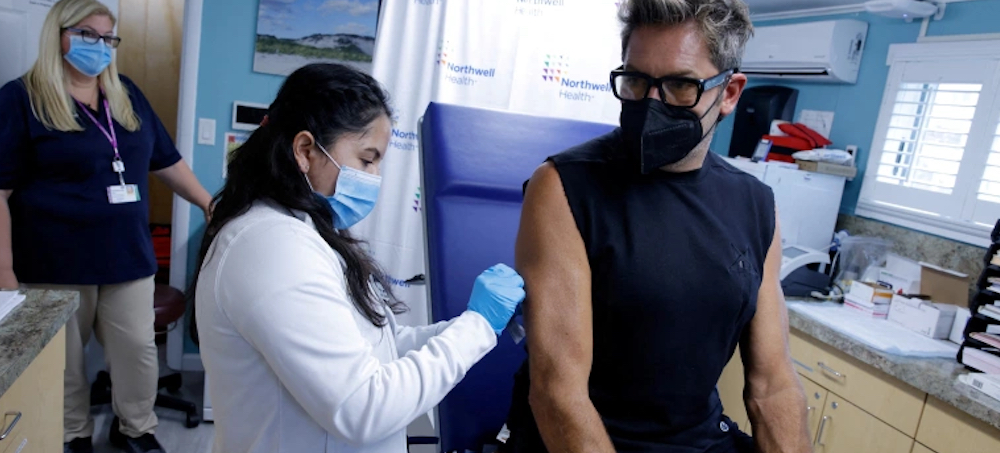 The WHO label could unlock funding and global efforts to collaborate on sharing vaccines and treatments. (photo: Eduardo Munoz/Reuters)
The WHO label could unlock funding and global efforts to collaborate on sharing vaccines and treatments. (photo: Eduardo Munoz/Reuters)
WHO declares monkeypox outbreak in more than 70 countries a ‘public health emergency of international concern’.
The WHO label – a “public health emergency of international concern” – is designed to sound an alarm that a coordinated international response is needed and could unlock funding and global efforts to collaborate on sharing vaccines and treatments.
Governments are advised to raise awareness among doctors and hospitals, take protective measures in suspected cases and educate members of the population on how to protect themselves from infection.
WHO Director-General Tedros Adhanom Ghebreyesus made the decision to issue the declaration despite a lack of consensus among experts serving on the UN health agency’s emergency committee. It was the first time the chief of the UN health agency has taken such an action.
Announcing his decision to declare the health emergency during a media briefing in Geneva, Tedros confirmed that the committee had failed to reach a consensus, with nine members against and six in favour of the declaration.
“We have an outbreak that has spread around the world rapidly through new modes of transmission about which we understand too little and which meets the criteria in the international health regulations,” Tedros said on Saturday.
“I know this has not been an easy or straightforward process and that there are divergent views among the members” of the committee, he added.
Tedros said there are now more than 16,000 reported cases from 75 countries and territories, and five deaths.
“There are characteristic monkeypox rashes that [people] should be looking at, particularly if they’re in an elevated risk group and they’ve had sexual relationships or close physical contact with somebody who might be ill,” said Lawrence Gostin, Director of the WHO Center on Global Health Law and Founding O’Neill Chair in Global Health Law at Georgetown University.
“There should be contact tracing…widespread testing and a strategic deployment of vaccines to try and nip this in the bud. But the window for containment of monkeypox is rapidly closing and we fear that this could become endemic in Europe, North America and other parts of the world over the next months,” Gostin told Al Jazeera from Washington, DC.
A global emergency is WHO’s highest level of alert, but the designation does not necessarily mean a disease is particularly transmissible or lethal.
WHO’s emergencies chief, Dr Michael Ryan, said the director-general made the decision to put monkeypox in that category to ensure the gobal community takes the current outbreak seriously.
Monkeypox has been established in parts of Central and West Africa for decades, but it was not known to spark large outbreaks beyond the continent or to spread widely among people until May, when authorities detected dozens of epidemics in Europe, North America and elsewhere.
“We should absolutely be worried [about monkeypox]. We’ve seen an exponential rise in monkeypox cases in five WHO regions of the world,” Gostin said.
“Outside of endemic areas in Central and East Africa, it’s primarily but not exclusively within communities of men who have sex with men but that should not lead to complacency. That community matters a lot and also could easily spill over into other communities, as we’ve seen with the HIV epidemic.”
To date, monkeypox deaths have only been reported in Africa, where a more dangerous version of the virus is spreading, mainly in Nigeria and Democratic Republic of Congo.
In Africa, monkeypox mainly spreads to people by infected wild animals like rodents in limited outbreaks that typically have not crossed borders. In Europe, North America and elsewhere, however, monkeypox is spreading among people with no links to animals or recent travel to Africa.
Last month, WHO’s expert committee said the monkeypox outbreak did not yet amount to an international emergency, but the panel convened this week to reevaluate the situation.
 A worker at an Amazon warehouse. (photo: Helen H. Richardson/Getty Images)
A worker at an Amazon warehouse. (photo: Helen H. Richardson/Getty Images)
Staffers at the Carteret, N.J., facility where a worker died during Prime Day last week said they were frustrated by a lack of information from the company.
The fatality, which occurred on July 13 during the company’s Prime Day shopping rush at a Carteret, New Jersey, fulfillment center, has kicked off an investigation by federal regulators at the Occupational Safety and Health Administration.
On Friday, Amazon rejected as “rumors” the concerns raised by some staffers that the death was work-related, with spokesman Sam Stephenson telling NBC News in a statement that the incident “was related to a personal medical condition.”
Stephenson said Amazon had conducted an internal investigation during which a fellow employee said that the worker who died had reported experiencing chest pains the evening before his shift but didn’t alert colleagues or managers at the warehouse.
The comments come after more than a week of growing frustration among facility employees, some of whom have criticized the company’s response. Amazon said in the days after the fatality that it was “deeply saddened by the passing of one of our colleagues” and that it had contacted the worker’s family to offer support. It also said it was providing counseling resources to employees.
Amazon hasn’t released any additional information about its investigation into the incident, the worker or conditions at the warehouse at the time.
Days after the employee’s death, warehouse management posted a remembrance card, viewed by NBC News, on a company bulletin board and distributed it in an internal note to employees. Some workers said they were upset that the card contained little information about the employee, identifying him only by first name, or what led to his death.
“Remembering our Rafael,” it says, next to a photograph of the employee. The text on the card said that Rafael had worked at the facility, called EWR9, for only a few months. It said he was “very hard working” and “always looking to help out where needed.”
“We will remember Rafael and give our condolences to his family,” the card said, noting that a funeral would be held in the Dominican Republic.
NBC News was unable to identify the worker’s full name or contact his family. The Dominican Republic's embassy in Washington didn't respond to requests for comment.
Two EWR9 employees who spoke to NBC News said the area where the employee died was on an upper floor and known for particularly high temperatures within the warehouse. Both workers requested anonymity for fear of reprisal. Their deceased colleague had worked as a “waterspider,” one of the workers said, a job that involves carting goods around the facility.
The other worker said she had asked her managers about his death but wasn’t given more information. One manager told her not to talk about it, she said.
She said frustration at the warehouse has run high since the fatality.
“It’s scary,” she said. "We should know what happened and how did it happen. It could have been any of us.”
Amazon said Friday that its internal investigation had ruled out working conditions as a culprit in the fatality and disputed labor leaders’ account of the timeline.
“We’re thankful for the quick actions of our own teams and the first responders,” Amazon's Stephenson said in the statement. “This has been a tragic situation for our employee’s family and for our colleagues at EWR9 who worked with him.”
On Thursday, Amazon Labor Union President Chris Smalls, who led a nearby Staten Island, New York, warehouse to a union victory this year, wrote on Twitter that the worker who died had been unconscious on the floor for more than 20 minutes and that it was nearly an hour before 911 was called. Smalls said the man was told to keep working after telling management he was experiencing chest pains.
Stephenson gave a different account Friday, saying that an onsite medical expert began emergency treatment immediately after the employee collapsed. Amazon said 911 was called immediately and arrived within 16 minutes.
Smalls didn’t return requests for comment.
Carteret recorded an outdoor high of about 92 degrees on July 13, according to AccuWeather, although the incident occurred in the morning.
Jon Salonis, a spokesman for the borough of Carteret, said that an emergency call first came in from the facility at about 8 a.m. and that the worker was subsequently transported to a nearby hospital.
Another EWR9 employee, Maria, who asked that her last name be withheld for fear of reprisal, said she used to work in the same department as the employee who died but left after suffering a hip injury and a burst blood vessel in her eye.
Maria said she worked an 11.5-hour shift last Sunday in the same part of the building where the worker had collapsed, which she described as a newer wing with limited air conditioning and fan access. With only a tiny “nine-dollar” fan placed near her station, she said, “I was struggling to breathe, I was feeling my blood pressure going up. I was feeling I’m going to pass out.”
She said her manager declined her request to transfer to a nearby empty station with a bigger fan. “What I was doing to survive was drinking cold water and going to the bathroom every 30 minutes.”
“Those people don’t care about people that work there,” she said of site managers. “They just want the job done.”
Amazon didn’t immediately respond to a request for comment about Maria’s experience or conditions in the part of the facility where she worked on Sunday.
Separately on Monday, officials from OSHA, the Labor Department's workplace-safety arm, inspected Amazon warehouses in New York City, Orlando and Chicago in response to referrals from the U.S. Attorney’s Office in Manhattan.
Investigators were examining the company’s pace of work, safety concerns, and “possible fraudulent conduct designed to hide injuries from OSHA and others,” law enforcement officials told NBC News.
Amazon said that it would “of course cooperate with OSHA in their investigation, and we believe it will ultimately show that these concerns are unfounded.”
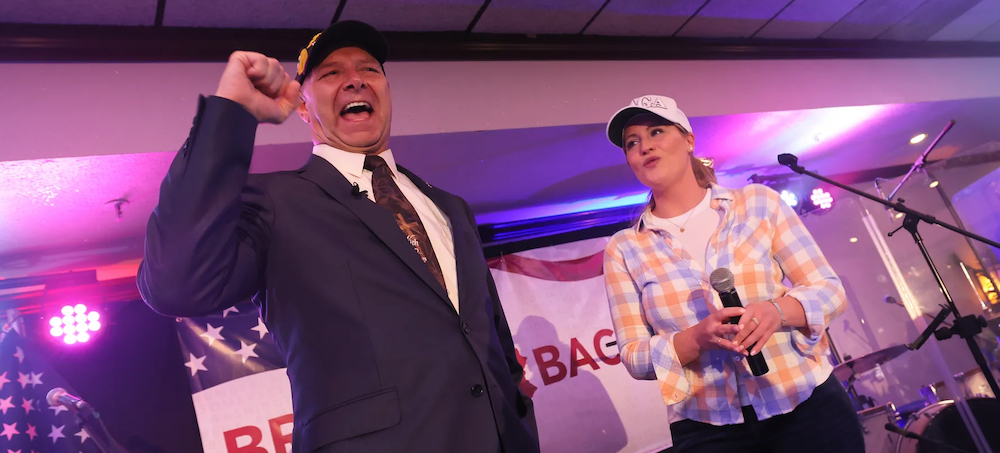 Pennsylvania Republican gubernatorial candidate Doug Mastriano greets supporters with Trump adviser Jenna Ellis, on stage for a May 17 event in Chambersburg, Pennsylvania. (photo: Michael M. Santiago/Getty Images)
Pennsylvania Republican gubernatorial candidate Doug Mastriano greets supporters with Trump adviser Jenna Ellis, on stage for a May 17 event in Chambersburg, Pennsylvania. (photo: Michael M. Santiago/Getty Images)
Is this reverse psychology a little too clever?
National Democrats, party-aligned nonprofits, and some of their candidates have together spent millions to elevate the most extreme positions of far-right candidates in races in Pennsylvania, Illinois, Colorado, and Maryland, and it’s a strategy that’s divided party operatives. The total investment this cycle was over $44 million as of last quarter, according to an Open Secrets analysis.
Party representatives have claimed it’s because they want to highlight the extremism of today’s GOP, knowing that even candidates who are running as “moderates” will feel pressure to appeal to voters on their right flank. They have denied that it’s with the intent of making extremist candidates more appealing to a Republican primary base and because they think it will be easier to beat those kinds of opponents in November.
But that’s what it looks like to some Democratic operatives, who have mixed reviews of that strategy. Some think it’s too dangerous and that it could lead to some of those extremist candidates actually getting elected. Democratic strategist Howard Wolfson told Politico that the strategy of “putting people into positions where they may actually get elected and have control over the election system in this country — people who don’t believe in democracy — is a very, very risky strategy.”
But others have said that Democrats are simply doing everything they can to give their candidates the best shot at winning in a tough cycle nationally, and also head off the need for major spending in the general election.
They’re not outright telling Republican voters to back extremist candidates. Rather, their ads are trying to employ reverse psychology and attacking candidates for being too extreme, which they know the GOP base will take as a high compliment.
“This is not a strategy that you deploy in every race,” said Jared Leopold, a Democratic consultant based in Virginia. “But the whole argument that Democrats shouldn’t be running ads in the primary is predicated on the idea that Republicans are not fully rotted with Trumpism. It’s clear that, no matter what Republican is nominated, they are going to get pushed to move to where their base is. So the best path is to do what you can to set up the best environment for Democrats to win.”
Has the strategy worked to make races easier for Democrats to win?
It’s not the first time Democrats have tried to manipulate GOP primaries. In 2012, then-incumbent Sen. Claire McCaskill ran a $1.7 million ad campaign designed to boost one of her Republican challengers, Rep. Todd Akin, by running ads that said he was too conservative for Missouri, knowing that “too conservative” would be a virtue in the eyes of many Republican primary voters. “I had successfully manipulated the Republican primary so that in the general election I would face the candidate I was most likely to beat,” she later wrote in a memoir, excerpted in Politico. “As it turned out, we spent more money for Todd Akin in the last two weeks of the primary than he spent on his whole primary campaign.”
Some of the extremist Republican candidates boosted by Democrats this cycle have gone on to win their party’s nomination.
In Maryland, the Democratic Governors Association launched an ad campaign in the final weeks before Tuesday’s primaries that linked Cox, one of the Republican gubernatorial candidates, to Trump and played up his far-right positions. The campaign criticizes him for being “100 percent pro-life” and for “refusing to support any federal restrictions” on guns. Politico reported that the DGA had reserved at least $1.2 million worth of airtime, which is more than Cox himself and the other Republican primary frontrunner, Kelly Schulz, had spent on advertising combined.
Cox won the nomination, though it’s not clear whether the DGA campaign pushed him over the edge. As of Thursday afternoon, the race was still too close to call on the Democratic side. But Maryland Democrats believe that, whoever their nominee, Cox is too far to the right to win a statewide race, and that he has no chance of winning over the Democrats and Democratic-leaning independents who previously voted for Republican Gov. Larry Hogan, who is term-limited.
In the Illinois Republican primary for governor, incumbent Democratic Gov. J.B. Pritzker and the DGA, which he helps fund using his billion-dollar fortune, spent almost $35 million total trying to paint Bailey, a pro-Trump Republican, as the most conservative candidate in the race. Ultimately, Bailey handily won the nomination.
And in Pennsylvania, state Attorney General Josh Shapiro, who is running for governor, spent more than $840,000 on TV ads ahead of the primaries saying that if Mastriano, one of his Republican opponents, prevailed, it would be a “win for what Donald Trump stands for.” Mastriano has been a fervent proponent of Trump’s 2020 election lies and was subpoenaed by the House committee investigating the January 6, 2021 insurrection for his involvement in busing rallygoers to the Capitol. He also ended up winning the nomination.
But the strategy wasn’t successful in Colorado or California. In the GOP primary for Colorado’s US Senate seat, Democratic groups spent roughly $4 million on ads designed to make far-right candidate Ron Hanks more appealing to GOP voters over his more moderate opponent, Joe O’Dea, who nevertheless won the nomination.
The Democratic-aligned PAC Colorado Information Network, which is primarily funded by the DGA, and liberal nonprofit ProgressNow Colorado also sank almost $2 million on ads painting former Parker Mayor Greg Lopez, who has embraced Trump’s 2020 election lies, as the ultra-conservative candidate in the Republican gubernatorial primary. And in Colorado’s Eighth District, House Majority PAC and other Democratic-aligned PACs spent nearly $300,000 on ads boosting Lori Saine over the more moderate frontrunner state Sen. Barbara Kirkmeyer. Both Lopez and Saine lost by considerable margins.
Democrats similarly tried to boost Chris Mathys in California’s newly drawn 22nd District, spending $110,000 on ads playing up his support for Trump, but his opponent Rep. David Valadao, who voted to impeach Trump following the Capitol insurrection, pulled through.
David Turner, a spokesperson for the DGA, pushed back on the idea that the organization is replicating McCaskill’s strategy this cycle with far-right candidates. He told Vox that, by making these investments in the primaries, the organization has merely “started the general election early and educated voters about the extremism of their positions on all sorts of things.”
He said that Cox and Mastriano were already among the frontrunners in their respective races by the time Democrats ran their ads, and that they’d also benefited from Trump’s endorsement. In April, before Shapiro’s May 5 ad boosting Mastriano aired, Mastriano was already leading the primary field, according to a poll by Eagle Consulting Group, a Republican consulting firm based in Harrisburg, Pennsylvania. And prior to the DGA’s July 1 ad, Cox also had a slight lead over Schulz in Maryland, according to a June Goucher College poll.
So to the extent that DGA’s ads might have made them more appealing to Republican primary voters, it’s because Republican primary voters were already energized behind far-right candidates, Turner said.
“Republican primary voters, again and again, are saying ‘This is what we want,”’ he said.
Will Democrats’ strategy backfire in the general election?
Democrats’ assumption that it’s easier to beat a more extreme right-wing candidate is a risky one. Former Democratic presidential candidate Andrew Yang, who has since left the party, called it “bad for the public and a symptom of how perverse our current system is.”
Certainly, it might be easier for a Democrat to run against a candidate who has been endorsed by Trump, who proved an effective villain in 2020, and especially so in left-leaning states like Illinois, Colorado, and Maryland. The strategy could pay off as a shrewd investment that will avert the need for heavier spending in the general election, freeing up funds that could be put toward more competitive races elsewhere.
But as history has shown, there’s still a risk that these far-right candidates will put up a fight and even get elected. In 2016, Hillary Clinton’s campaign made the mistake of seeking to elevate Trump and other “Pied Piper” Republican presidential candidates with extreme conservative views in the primaries over the more establishment Republicans then perceived as her true rivals.
The poll numbers in Pennsylvania — a state where Republicans hold a 2 percentage point advantage, according to the 2022 Cook Partisan Voting Index — aren’t encouraging for Democrats hoping to avoid a repeat of 2016. Mastriano is trailing Shapiro by no more than 4 percentage points across three separate polls conducted in June by Cygnal, Suffolk University, and Fabrizio, Lee and Associates/Impact Research.
That said, Mastriano still faces an uphill battle in the state, where he’ll need to broaden his appeal beyond the GOP base. So far, he’s not getting much help from the party establishment: nine current and former Republican state officials have endorsed Shapiro over Mastriano. The Republican Governors Association has yet to announce plans to come to his aid, despite Mastriano’s pitch at an RGA meeting in Colorado earlier this week where he said, “We must all hang together, or, most assuredly, we shall all hang separately.” Shapiro has also spent more than $4.7 million on ads since the primary, whereas Mastriano has not spent anything.
The other states where Democrats have boosted right-wing candidates look safer. In Illinois, Pritzker had a 7 percentage point advantage over Bailey in a June Fabrizio, Lee and Associates poll.
Although the Democratic primary results in Maryland are still being tallied, there’s reason for Democrats to be confident heading into the fall. President Joe Biden won Maryland by more than 30 percentage points in 2020, and there are more registered Democrats in the state than Republicans. If there are grounds for Maryland Democrats to be nervous, it’s that none of their candidates have really been able to distinguish themselves from the rest of the pack in the primary, and that could make it harder for the ultimate winner to energize voters ahead of November. None polled above 16 percent among primary voters, according to a survey conducted last month by Goucher College in partnership with WYPR and the Baltimore Banner.
The message that Democrats are going to deliver in the general election in those races is the same as the ads they’ve been running in the primaries: that the Republican Party has “gone off the rails,” Turner said.
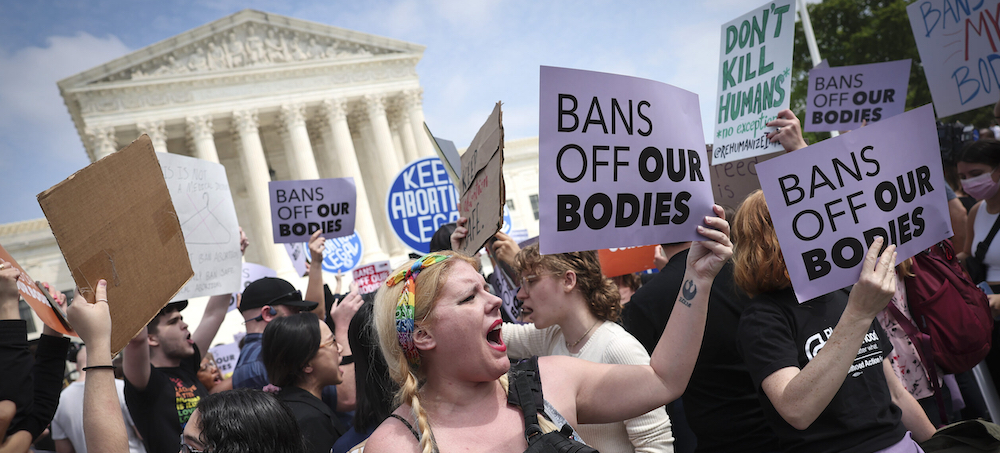 Abortion-rights and anti-abortion activists confront one another in front of the U.S. Supreme Court Building in Washington, D.C. (photo: Win McNamee/Getty Images)
Abortion-rights and anti-abortion activists confront one another in front of the U.S. Supreme Court Building in Washington, D.C. (photo: Win McNamee/Getty Images)
As lower courts grapple with rapidly changing state laws, patients wonder from day to day if abortion is still legal, and even if legal, whether it is still available in their states. Health professionals in states with abortion bans fear prosecution by state authorities for performing abortions or by federal authorities for not performing them in life- or health-threatening situations.
Even employers are caught between conflicting state and federal rules about what can, cannot, and must be covered by insurance.
But amid all the confusion, there are some things that are simply not true. Here are three myths going around about the abortion debate:
MYTH 1: Only people seeking abortions are affected by the Supreme Court's action.
The huge changes and uncertainties wrought by the Supreme Court's erasure of 49 years of largely settled federal policy most directly affect pregnant women. But they are far from the only people whose medical care is being disrupted.
As abortion providers pack up and leave states with bans, they may take with them expertise in managing high-risk pregnancies as well as routine deliveries, particularly in less-populated areas, plus access to long-acting birth control and screening and treatment for cancer and sexually transmitted diseases.
Similarly, medical students and medical residents may not want to train in states where they can't learn abortion techniques, which are often the same as care for miscarriages. That could lead to shortages of people trained to help patients give birth safely just as more people are being forced to carry pregnancies to term.
Also affected, at this point as much by accident as intent, is birth control. In Missouri, a hospital system temporarily stopped distributing the "morning after" birth control pill, which is a contraceptive that does not cause abortion, before reversing the decision.
That is its own sub-myth — that the Plan B morning-after pill is the same as the abortion pill mifepristone. Plan B is a high dose of regular birth control that prevents ovulation but does not interrupt an existing pregnancy. Mifepristone ends a pregnancy if used in approximately the first 10 weeks.
And it's not just pregnant women who are affected by the uncertainty. People with severe psoriasis, lupus and other autoimmune disorders are already reporting difficulty obtaining methotrexate, a first-line medication for those ailments that can also be used as an abortion medication.
MYTH 2: The Democratic Congress could have codified abortion protections long before now, but chose not to.
The House on July 15 voted — for the second time by this Congress — for a bill that would effectively codify the federal abortion protections of the 1973 Supreme Court decision Roe v. Wade. Ever since the court overturned that decision last month, Democrats on social media and elsewhere have complained that this is a bill Congress should have passed years ago, when the Democrats had firmer control of the House, the Senate and the White House.
But even though Democrats had bigger majorities in Congress under Democratic Presidents Bill Clinton and Barack Obama, large numbers of anti-abortion Democrats in both chambers effectively meant there was not a majority for such legislation, much less the 60-vote supermajority that would have been required in the Senate.
It was not, contrary to some revisionist historians' views, for lack of trying. In 1992, Democratic leaders promised to bring the "Freedom of Choice" act to the floor, a bill that would have written the right to abortion into federal law, if only to embarrass then-President George H.W. Bush right before the GOP convention. (Here is a very old clip of me explaining the situation on C-SPAN.) In the end the bill did not make it to the floor of either the House or the Senate, as Democratic leaders could not muster the votes.
In fact, since the Roe ruling, the House has been more anti-abortion than the Senate, in part because so many Democrats from Southern and/or conservative districts opposed abortion (most have now been replaced by Republicans), and because the Senate has long had at least a handful of Republicans who support abortion rights. Today that is limited to Sens. Susan Collins (R-Maine) and Lisa Murkowski (R-Alaska). The House got its first abortion-rights majority only in 2019, when Donald Trump was president.
MYTH 3: Congress could simply eliminate statutory abortion restrictions now.
With Democrats in charge of both Congress and the White House, they can just change the existing laws limiting abortion, advocates claim. Indeed, President Joe Biden's budgets in 2021 and 2022 proposed eliminating the so-called Hyde Amendment, named for its sponsor, the anti-abortion crusading Rep. Henry Hyde (R-Ill.), which has barred most federal abortion funding since the late 1970s. But while the House voted in 2021 for the funding bill for the Department of Health and Human Services without the abortion rider for the first time in decades, Senate Republicans forced the restrictions back into the final measure. The same is expected later this year. Democrats hold only 50 seats in the Senate and need at least 10 Republicans on any bill that is threatened with a filibuster.
The Hyde Amendment could also keep the federal government from allowing abortion clinics to operate on federal land, as many progressives have been calling for. But other, more complicated federal-state issues would more likely doom that scenario.
Complicating things still more, the Hyde language in the HHS spending bill is far from the only abortion restriction embedded in federal law. While abortion-rights backers have successfully fought off most efforts to make such restrictions permanent, various other spending bills annually include limits on abortion in the military, in federal prisons, by the Indian Health Service, and as an insurance benefit for federal workers. Congress has also limited the ability of the District of Columbia to spend local tax dollars on abortion.
It is possible the reversal of Roe could lead to the reversal of some of these restrictions. But with Democrats' paper-thin majority in the Senate, it's not likely, at least not in 2022.
 Alaihia Lloret holds a megaphone during a protest in Los Almendros beach. (photo: Ricardo Arduengo/Guardian UK)
Alaihia Lloret holds a megaphone during a protest in Los Almendros beach. (photo: Ricardo Arduengo/Guardian UK)
Locals and climate activists battle against coastal development and privatization of public beaches as luxury condos proliferate
Wearing swimsuits and holding tight to their sledgehammers, hundreds of people flocked to Los Almendros beach in early July to take apart a structure that would have been an infinity pool just a few yards away from the coast. The protests against the structure, which a condominium started building last year, continues to grow and activists are still expressing their concern over the construction’s effect on the area.
The protests in Rincón are part of a larger battle spearheaded by environmental activists against coastal development and privatization of public beaches in Puerto Rico. After Hurricane María hit the island in 2017, communities faced elevated erosion and more infrastructure along the coast. The proliferation of housing developments and hotels in places with a high volume of tourists, like Rincón, have also presented a challenge to locals trying to access the beach.
In the case of the protests around the condominium’s beachside pool, the law is on the citizens’ side: a lower court in Puerto Rico ruled in favor of demolishing the structure earlier this year, but the condominium owners have repeatedly appealed the court’s decision. The move has led to a resurgence of protests in Los Almendros and the revival of Camp Carey, named after a hawksbill turtle.
For Alaihia Lloret, a tent in Los Almendros beach has become her second home as she protests against coastal development. Lloret, 19, started camping out in Los Almendros beach with dozens of other people last year after a condominium began construction. When a turtle nested in the area, protests erupted, forcing the condominium to stop the reconstruction of the infinity pool last summer, which was destroyed by the hurricane in 2017.
“This feels personal because I’ve been coming to this beach all my life,” said Lloret, who is a student at the University of Puerto Rico in Mayagüez. “Once I saw what was happening, I knew I had to take it upon myself to protest.”
The call to protect the island’s beaches has created a movement to organize “party protests” in areas threatened by overdevelopment, anchored by the slogan “Las playas son del pueblo,” or “The beaches belong to the people.” By law, every beach in Puerto Rico must have public access.
“Construction in the coast not only puts the marine-terrestrial zones and public domain in danger, but you’re also risking people’s lives in the properties,” said Wilmar Vázquez, a member of the group In Defense of Our Beaches, which organizes the party protests. “Hurricane María was an eye-opener and a step toward change.”
Vázquez’ group organized a series of protests earlier this year against construction along the coast and privatization. Hundreds of people convened at the wealthy sector of Ocean Park in January after a viral video showed a couple asking beachgoers to leave the area, raising the idea that they could enjoy the beach only if they bought a million-dollar property nearby. Another protest erupted in February at Dorado beach, a Ritz-Carlton Reserve.
But Rincón epitomizes all the other problems Puerto Ricans are contending with as the island experiments with a new period of austerity measures amid its debt restructuring agreement. A tax incentive intended to attract outside money has led to exorbitant rent prices in coastal towns, displacing families that have been living in these areas for generations. As wealthier investors arrive to the island, the demand for luxury-style properties continues to jump.
The soaring gentrification adds fuel to the protests in Rincón, and the people at Camp Carey said they are seeking new ways to obstruct further construction at the beach.
“We’re counting on the supreme court to protect the right to private property,” Leonor Porrata Doria, the legal council for the condominium’s board of directors. Porrata added that the protesters don’t “represent the people” of Puerto Rico. “Imagine people overthrew a fence in a private house and started camping out in the back yard.”
The department of natural and environmental resources in Puerto Rico announced last week that it would start a demarcation process to determine the marine-terrestrial zone, which is considered public, in Los Almendros beach. The process is long overdue because erosion and the climate crisis have drastically altered the initial demarcation granted in 1996, when the building’s permits were granted, and many experts question the legality of the original construction.
“Demarcations are valid for five years,” said Pedro Cardona Roig, an architect and former member of the Puerto Rico Planning Board. “If no hurricanes or extraordinary tidal waves occur, the demarcation stays valid.” But that’s not Puerto Rico’s case.
Despite the agency’s efforts, the camp members fundraised to hire their own surveyors and other scientists to execute the same process amid distrust in the government.
“The condominium can search for all the help they want, but the science is undebatable,” said Eliezer Molina, an activist and former independent candidate for governor. “The people are learning that there’s new routes we can take, and this will continue to replicate.”
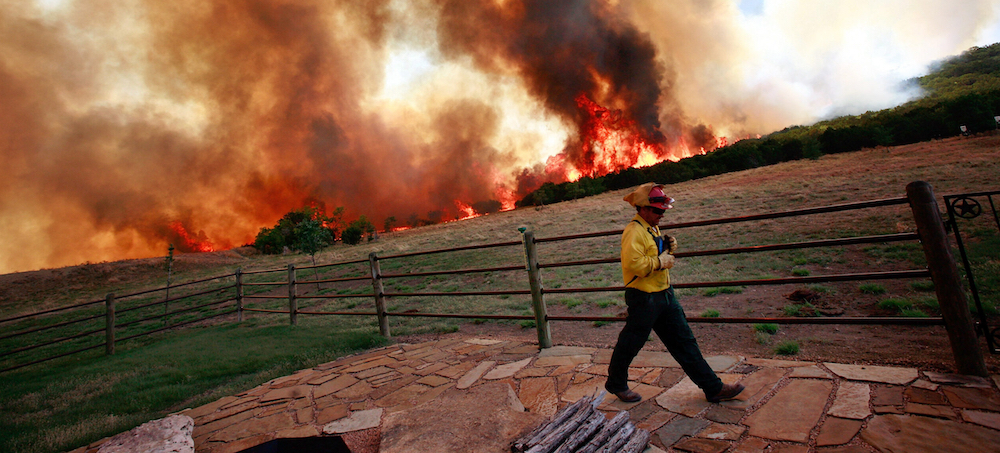 Emergency crews battle a wildfire in Texas. (photo: Tom Pennington/Getty Images)
Emergency crews battle a wildfire in Texas. (photo: Tom Pennington/Getty Images)
This week I watched an international newscast and saw what looked like most of the planet — the Americas, Africa, Europe, Asia — painted in bright, blaring orange and reds, like the Burning Bush. Fahrenheit temperatures in three-digit numbers seemed to blaze all over on the world map.
Heat records have burst around the globe. This very weekend, crops are burning, roads are buckling and seas are rising, while lakes and reservoirs recede, or even disappear. Ice sheets melt in rising heat, and wildfires blitz forests.
People are dying in this onerous heat. Lives of all kinds are threatened, in cities, fields, seas, deserts, jungles and tundra. Wildlife, farm animals, insects and human beings are in distress.
The U.N.'s World Meteorological Organization says there is more lethal heat in our future because of climate change caused by our species on this planet. Even with advances in wind, solar and other alternative energy sources, and international pledges and accords, the world still derives about 80% of its energy from fossil fuels, like oil, gas and coal, which release the carbon dioxide that's warmed the climate to the current temperatures of this scalding summer.
The WMO's chief, Petteri Taalas, said this week, "In the future these kinds of heatwaves are going to be normal."
The most alarming word in his forecast might be: "normal."
I'm of a generation that thought of summer as a sunny time for children. I think of long days spent outdoors without worry, playing games or just meandering. John Updike wrote in his poem, "June":
The sun is rich
And gladly pays
In golden hours,
Silver days,
And long green weeks
That never end.
School's out. The time
Is ours to spend.
There's Little League,
Hopscotch, the creek,
And, after supper,
Hide-and-seek.
The live-long light
Is like a dream...
But now that bright, "live-long light," of which Updike wrote, might look menacing in a summer like this.
In blistering weeks such as we see this year, and may for years to come, you wonder if our failures to care for the planet given to us will make our children look forward to summer, or dread another season of heat.
Special Coverage: Ukraine, A Historic Resistance
READ MORE
Follow us on facebook and twitter!
PO Box 2043 / Citrus Heights, CA 95611

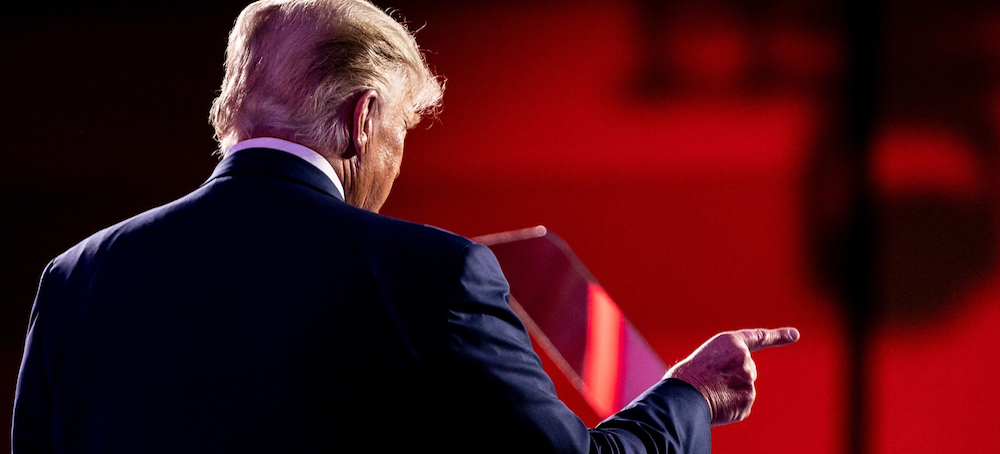

No comments:
Post a Comment
Note: Only a member of this blog may post a comment.